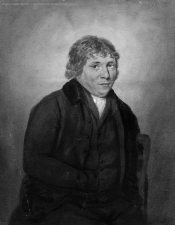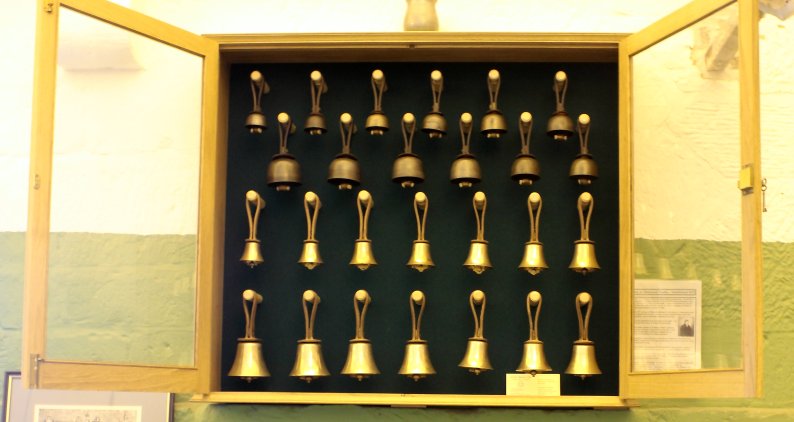
Image provided courtesy of
Nottingham City Museums and Galleries
Click image to enlarge
 |
| Artist: Richard Bonington Image provided courtesy of Nottingham City Museums and Galleries Click image to enlarge |
The Sherwood Youths rang their first peal, also being the first in the tower at Nottingham St Mary on Tue Feb 3 1761. Appearing in the 3rd peal for the Society in 1765 was William Doubleday Crofts (WDC). By the 5th peal, and the first at Nottingham St Peter, WDC was conducting the peals, and with only a few exceptions he conducted all the peals through to the Society's 35th peal on Nov 11 1793.There is no record of where WDC came from though it may be from Norfolk or London and he may have been a relative of John Garthon whose manuscripts and papers he inherited. He was a solicitor running his own business and he was a relatively rich man, certainly compared to many of the local ringers who were local artisans, framework knitters, carpenters and even a bell founder. He was without question a very able heavy end ringer as his performance of ringing some large back bells single handedly whereas before they always required 2 people. It was no mean feat to ring the 9th and conduct the 10260 Grandsire Caters at Nottingham St Mary on Tue Mar 3 1778 in 7hours 22minutes considering that they would be on plain bearings in a wooden frame and rung from a gallery below the current ringing chamber.
During his time with the Sherwood Youths there was much activity and as well as the main Nottingham towers they rang first peals at Uppingham and Newark-upon-Trent (1773), King's Norton (1776), and Caythorpe (1778).
WDC was well respected as a ringer and a composer. He was the first Nottingham ringer to join the London based "Ancient Society of College Youths" in 1765 and he helped ring the tenor behind to the first peal on the new bells at York Minster in 1787. He was also the Steward to the Union Society of Shrewsbury in 1781, an honour bestowed upon him, no doubt, in gratitude for supplying the composition of 10,080 Plain Bob Major rung by them on 25th February 1777 .
He was a formidable composer, and his collection contains the composition of the first known true peal of Grandsire Triples, rung at Norwich in 1718, and compositions for many other methods. He probably was one of the first to realise that treble bob methods could be false internally in all stages above 1/2. His Manuscripts are lodged with the Nottingham Archives with a copy being held by the Secretary. There are two known Crofts' compositions of Double Bob Royal (Double Ten In). There is no record of which composition he used for the peal at Nottingham St Mary on Mon Mar 7 1791 and it is hoped that he used neither as, much to the annoyance of a band that rang the left hand option at the same tower on Sat Dec 5th 2009 to commemorate the 200th anniversary of his death, both compositions are false.
A more detailed description of his life and composition work is in George Dawson's William Doubleday Crofts of Nottingham, a reappraisal

Click image for close up of Cup Bells Any visitor to the ringing chamber at Nottingham St Mary cannot fail to notice the peal boards all but two of which are performances by the Sherwood Youths.
Additionally the old set of cup bells in the cupboard were gifted by Squire Fortrey (King's Norton/Norton by Galby, Leicestershire), a great supporter of all things campanological, as a prize as a result of competition for the long peal between the Leicester Scholars and the Sherwood Youths in 1777.
Click image to see detailed gravestone William Doubleday Crofts died on 29th November, 1809 and was buried on 5th December in the NW corner of St Mary's churchyard. He is described as being 72 though there is conflicting information. His death was reported in the local newspapers. George Dawson has a copy of his will which for unknown reasons took several years before it was proved and WDC left all to one Joseph Hewitt. Buried in the same grave is a George Dickisson, reputed to be WDC's son-in-law, but probably not so.
The Society continued to be active following WDC's death and infuriated the local ringers by beating them to ring the first peal on the bells at Ashbourne which resulted in a fist fight in the churchyard.
However towards the end of the 19th century the emergence of the Midland Counties Association eclipsed the Society.
In 1924 Albert Coppock, Ringing Master at Nottingham St Mary's, whose great-grandfather had rung with WDC, revived the Society whose objectives include having an annual dinner in commemoration of WDC. Accepting that there were still two members alive from 19th century the Society can claim continuity back to 1672 making it one of the oldest ringing Societies still performing as such.
The early dinners were major occasions attended by the Mayor or Sheriff of Nottingham. A surviving photograph shows the 1928 dinner. The photograph belonged to Miss Ida Belle Thompson who became the first lady to ring a peal for the Society in 1926.
In most years an Annual Dinner is held in commemoration of William Doubleday Crofts and it is hoped that this article will help the reader understand the Society's place in local ringing as well as its importance nationally and historically.